Generalizations regarding the U. S. Army Uniform of the Civil War
By Dr. Howard G. Lanham
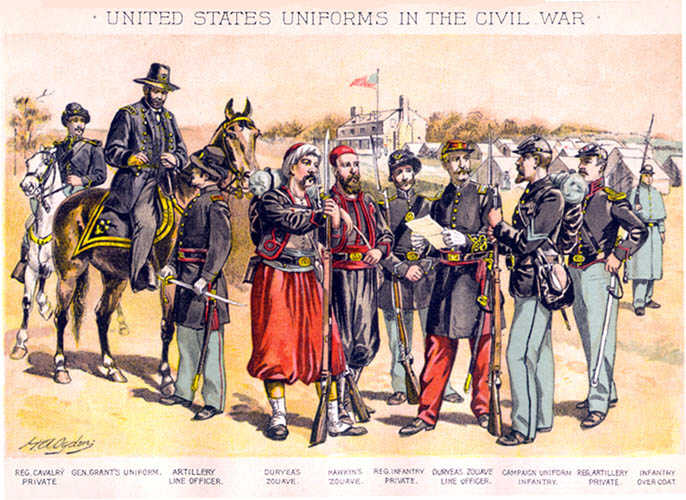
Uniform Plate by Henry A. Ogden (1856-1936)

The uniform worn by the U.S. Army during the Civil War of 1861-1865 developed over a long period of time and is the result of many different traditions and influences.
The most notable feature of the uniform coat was its dark blue color. The tradition of the Army wearing blue dates from the Revolutionary War when many of the American units wore blue. The color blue was officially adopted by Congress on October 2, 1779. During certain periods individual units of the Regular Army may have been uniformed in other colors, even bandsmen in red, but blue predominated. The tradition carries forward until today when the Army dress uniform is still dark blue in color. The notion of a soldier wearing a uniform that served to camouflage him would have been very foreign to the thinking of period military officers. Conventional military tactics involved maneuver of massed men on open ground in full view of the enemy and soldiers were expected to be brave under fire. Many officers believed that field fortifications robbed men of their will to fight aggressively and forbade their men to build them. By the later part of the war casualties taught otherwise and the field works at Petersburg were every bit as sophisticated as those of the First World War. However, it was not until the Spanish-American War that the Army adopted uniforms of a khaki color that had some camouflage value.
Similarly the uniform was made of wool and no effort was made to produce a uniform that would be comfortable in warm climates. It was not unusual for soldiers to dress more casually while on campaign, but the standards of the day were unforgiving and gentlemen did not appear in public in their shirt-sleeves. Heat stroke was a common occurrence while on the march in hot weather.
Certain uniform items were light blue. This material was much less expensive to purchase during the period. The quartermaster enjoyed the cost savings of the light blue pants and overcoats and they also provided a contrast in color. The Invalid (Veteran Reserve) Corps, established during the war to return wounded men to limited service, wore a totally sky blue uniform.
Another notable feature of the American uniform insignia is the use of the eagle motif. The eagle is a symbol of the United States and was officially adopted as the central element of the seal of the United States. Eagles were used to pin the side of the hat up, as the motif on many of the buttons, on the cartridge box cross belt plate and on the sword belt plate. The abbreviation U.S. appeared on the oval belt buckle and cartridge box plate.
In other ways the uniform reflected civilian influences. The basic frock (uniform) coat and the sack (fatigue) coat were based on civilian styles. There was a resistance on the part of some older officers to the adoption of these coats in that they were not military in appearance. The Jeff Davis or Hardee hat, adopted in 1855 for cavalry and in 1858 for the Army in general, had almost no military precedent and may have even been more unpopular. The uniform dress cap of 1872 replaced the Jeff Davis hat with a cap that is a cross in appearance between a kepi and a shako with a pompom in the front. It may look ridiculous to modern eyes but satisfied the contemporary sense of headgear having a military appearance, something the Jeff Davis hat lacked.
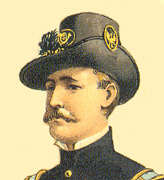
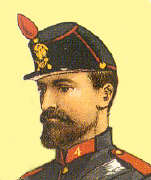
Foreign influences on American uniforms remains a controversial subject among those interested in uniforms. It is undeniable that Americans followed European trends and frequently imitated them. There were two influential foreign powers to which America looked. The first was Great Britain and the second France. Britain had been the United States colonial master and the enemy in two wars, but there were nevertheless very strong cultural and commercial tries. However, the U.S. Army leadership were War of 1812 veterans and tended not to favor things British.
France on the other hand had been an ally in the Revolution. The military resurgence of France under Napoleon III attracted American interest in French uniforms. French was part of the curriculum at West Point and American officers regularly visited France to study new developments. To have visited France and to be fluent in French added to the prestige of individual American officers, such as McClellan, Halleck and even Irvin McDowell. The American Army adopted French-based systems of tactics.
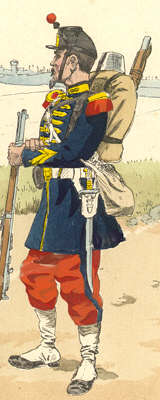
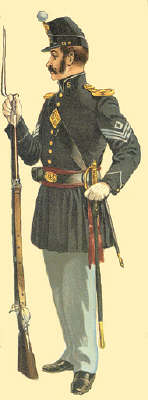
Europeans often find the American uniform of the period rather drab compared to the rather fancy dress of the European armies. This was deliberate on the part of those prescribing the United States Army uniform. The attitude was that this was the uniform of a republic and a gaudy uniform reflected the livery of servants and the autocratic traditions of Europe that the United States was turning away from. Congress was leery of a standing army and would not tolerate or fund an overly fancy uniform for either officers or enlisted soldiers. Members of militia units purchased their own uniforms and could design a fancier uniform if they so pleased. During the war years attitudes soften and if Zouave uniforms helped to enlist soldiers they were at least tolerated among the volunteers, but never in the Regular Army.
The uniform adopted by the United States in 1851 shows heavy French influence. The basic cut of the uniform coat adopted in 1851 is French. The French were the first to adopt a uniform based on the frock coat, while the British were among the last. The cap of 1851 was a copy of the French model of 1844. Like their French counterparts, enlisted men wore collar ornaments and worsted epaulettes, but by March 1858 all three of the latter items were dropped. The kepi or forage cap is another good example. Also, the American use of Zouave uniforms is well-known. Among the most drastic examples of French influence was the purchase of 10,000 French Chasseurs à pied uniforms. These were issued to 62nd and 83rd Pennsylvania and 18th Massachusetts and also to the the Excelsior Brigade (70th, 71st, 72nd, 73rd, and 74th New York). Plans for additional purchases ran afoul of domestic politics and the tendency for the French uniforms to be cut too small for Americans. For a complete discussion of the Chasseur uniform see the articles by Don Troiani beginning in the XXVI (2) issue of the magazine North South Trader's Civil War. Other European powers, such as Austria or the German states, seem to hold very little interest among Americans who did not feel that the military culture of these countries were worthy of imitation.